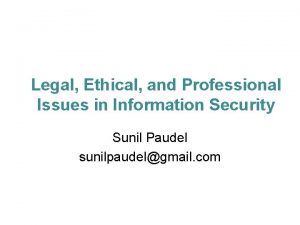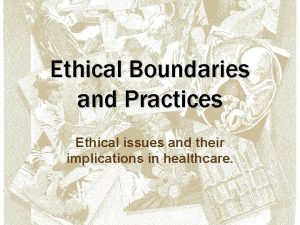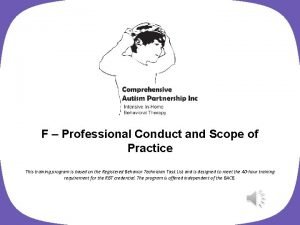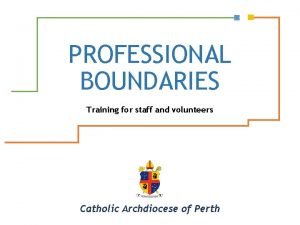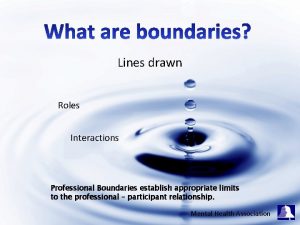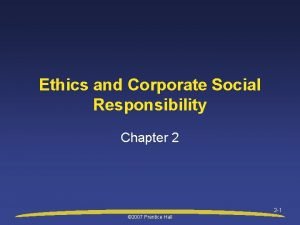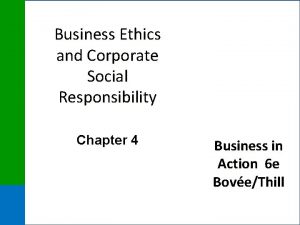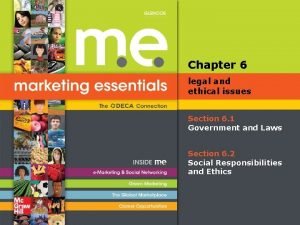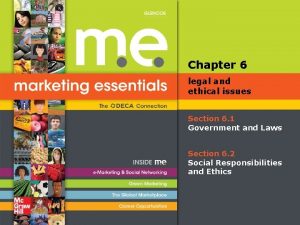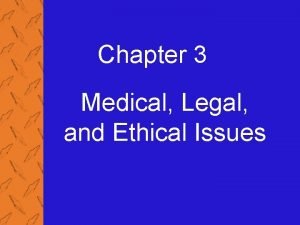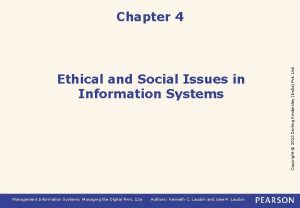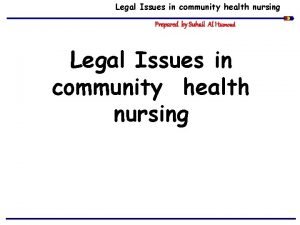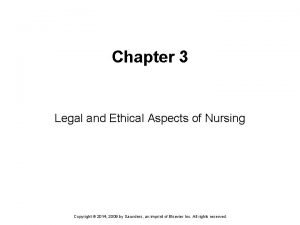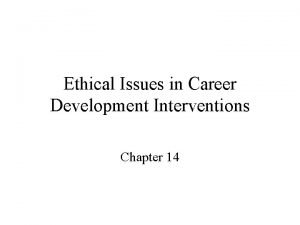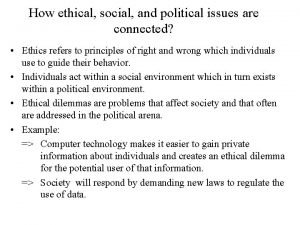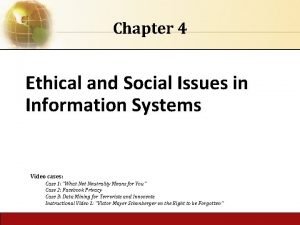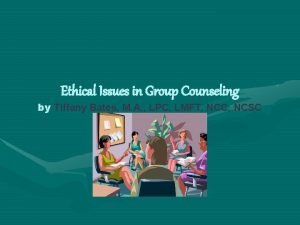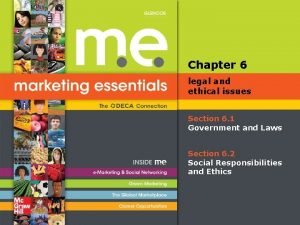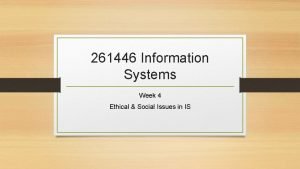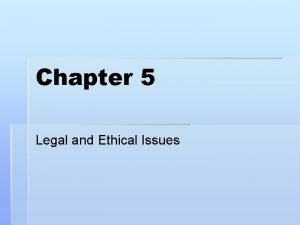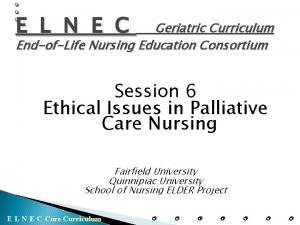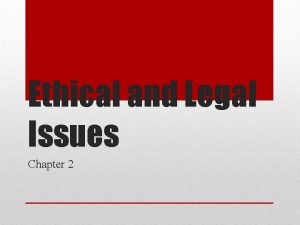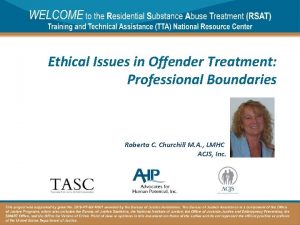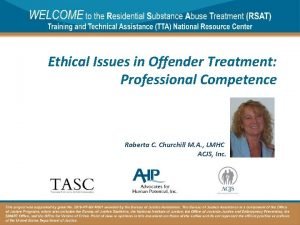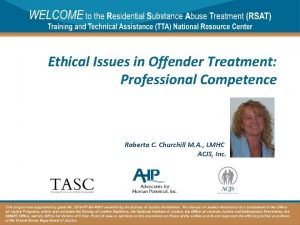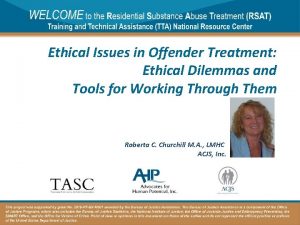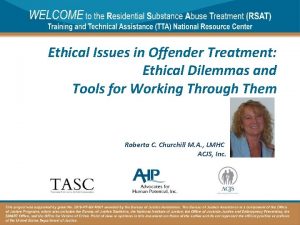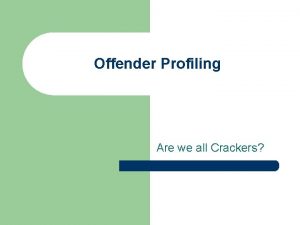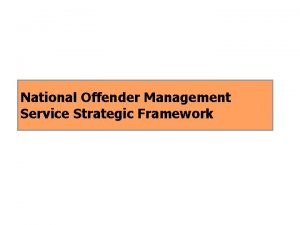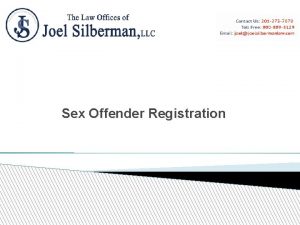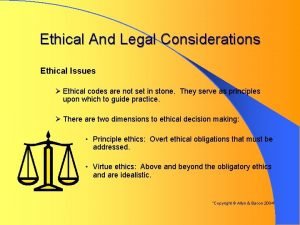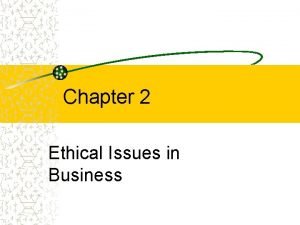Ethical Issues in Offender Treatment Professional Boundaries Roberta

Ethical Issues in Offender Treatment: Professional Boundaries Roberta C. Churchill M. A. , LMHC ACJS, Inc.

Course Objectives Upon completion of this presentation, participants will be able to : Ø Define the concept of “power differential” Ø Identify three types of boundaries and their relevance to offender treatment List three warning signs that boundaries may be at risk of being crossed / compromised Ø Ø Develop a plan of action if boundaries are in danger of becoming unprofessional / boundaries have been crossed 12/2/2020 2

THE PROVIDER-CLIENT RELATIONSHIP 3

The Power Differential The unbalance of power between provider and client Control over the services provided to the client Access to private knowledge about the client 12/2/2020 4

Examples of the Power Differential Module I: Research Ø Set the time and place: Set / changes schedules, begin / end classes, decide where / how to run classes, when / how drug testing occurs Ø Set the stage: Can arrange seating, change classroom, allow / deny participants to leave classroom, etc. Ø Right to ask questions: Ask offenders questions in the course of their work, but do not necessarily answer all their questions 12/2/2020 5

Examples of the Power Differential Module I: Research Ø Maintain anonymity: Know much more about offenders than offenders know about staff Ø Power to label, name and diagnose: Interpret, analyze, recommend and review progress of offenders; this can affect eligibility for parole, classification and aftercare recommendations Ø Authority to determine the rules of the relationship: Staff review program rules, probation / parole conditions, and “set the tone” for interactions 12/2/2020 6

Module I: Research "Because a relationship begins with a power differential, I shall not exploit relationships with current or former clients for personal gain, including social or business relationships. " (National Association of Alcoholism and Drug Abuse Counselors, 2004) 12/2/2020 7

BOUNDARIES What are they? Where are they? When are they at risk? 8

Zone of Helpfulness Module I: Research Staying within the “zone” helps you to stay “in bounds”. 12/2/2020 9

Context is Key Context – not content – often determines the appropriate boundary. 12/2/2020 10

Physical Boundaries Ø Hugging, hand holding, any type of intentional touching Ø Aggressive / violent intent behaviors Ø Invading another’s “space” or personal property 12/2/2020 11

Physical Boundaries Ø An educator leans over a seated client touching his shoulder while looking over his written work 12/2/2020 12

Physical Boundaries Ø An educator leans over a seated client touching his shoulder while looking over his written work Ø An Officer touches a client’s hand as she begins to cry when telling them about her children at home 12/2/2020 13

Physical Boundaries Ø An educator leans over a seated client touching his shoulder while looking over his written work Ø An Officer touches a client’s hand as she begins to cry when telling them about her children at home Ø A counselor gives a hug to a client after they receive bad news from home 12/2/2020 14

Emotional / Psychological Boundaries Ø Using clients / client information to satisfy one’s own emotional / dependency needs Ø Using psychologically manipulative behaviors in an attempt to intentionally or unintentionally gain more control of the situation or be the more powerful person 12/2/2020 15

Emotional Boundaries Module I: Research Ø A counselor talks about her past sexual abuse in detail with the female clients that disclose to her a similar background 12/2/2020 16

Emotional Boundaries Module I: Research A counselor talks about her past sexual abuse in detail with the female clients that disclose to her a similar background Ø An RSAT Officer offers to be an AA sponsor to one of his RSAT community members Ø 12/2/2020 17

Emotional Boundaries Module I: Research A counselor talks about her past sexual abuse in detail with the female clients that disclose to her a similar background Ø An RSAT Officer offers to be an AA sponsor to one of his RSAT community members Ø A facilitator shares the gruesome details of his divorce during a Healthy Relationships group with clients Ø 12/2/2020 18

Module I: Research “Are my actions more about my needs than about the needs of the client? ” 12/2/2020 19

Psychological Boundaries Module I: Research Ø Shaming a client in front of others - “You aren’t doing anything right in this Unit. Maybe you need some time in isolation. ” 12/2/2020 20

Psychological Boundaries Module I: Research Shaming a client in front of others - “You aren’t doing anything right in this Unit. Maybe you need some time in isolation. ” Ø During an intake interview with a client, a staff member answers the phone several times Ø 12/2/2020 21

Psychological Boundaries Module I: Research Shaming a client in front of others - “You aren’t doing anything right in this Unit. Maybe you need some time in isolation. ” Ø During an intake interview with a client, a staff member answers the phone several times Ø A white staff member calls a black client a racist name Ø 12/2/2020 22

Sexual Boundaries Ø Any type of sexual behavior (touching or not) in the office Ø Any type of inappropriately sexual innuendo or language with clients Ø Any type of inappropriate clothing in the office 12/2/2020 23

Sexual Boundaries � 2007 About 54% of substantiated incidents of sexual victimization involved only inmates, while 46% of substantiated incidents involved staff with inmates. Paul Guerino and Allen J. Beck, Bureau of Justice Statistics, “Sexual Victimization Reported by Adult Correctional Authorities, 2007 -2008, ” January 2011 12/2/2020 24

Sexual Boundaries Paul Guerino and Allen J. Beck, Bureau of Justice Statistics, “Sexual Victimization Reported by Adult Correctional Authorities, 2007 -2008, ” January 2011 12/2/2020 25

Sexual Boundaries Ø A staff member winks at a client seductively during group 12/2/2020 26

Sexual Boundaries Ø A staff member winks at a client seductively during group Ø A counselor asks about a client’s past sexual history that have nothing to do with current treatment 12/2/2020 27

Sexual Boundaries Ø A staff member winks at a client seductively during group Ø A counselor asks about a client’s past sexual history that have nothing to do with current treatment Ø An Officer wants to know about a client’s sexual preferences; always tries to steer the conversation back to the topic of sex 12/2/2020 28

Prevention and Avoidance of Sexual Misconduct Module I: Research Do not use: • Gestures, tone of voice, expressions or any other behavior that a client could interpret as seductive, sexually demeaning or sexually abusive Refrain from: • Treating a client with whom you have had a previous intimate relationship Do not make: • Sexualized comments about a client’s body or clothing; sexualized or sexually demeaning comments to a client Do not: • Criticize sexual orientation; ask details of sexual history – unless it’s part of your job 12/2/2020 29

Prevention and Avoidance of Sexual Misconduct Module I: Research Do not: • Engage in inappropriate “affectionate” behavior with a client; talk about your own sexual preference, fantasies, problems, etc. Learn: • To detect and deflect seductive clients Do not: • Request a date with a client; engage in any sexual conduct Maintain: • Good records that reflect any intimate questions of a sexual nature and document any and all comments or concerns made by a client relative to alleged sexual abuse, and any other unusual incident that may occur during the course of the work day 12/2/2020 30

THE GRAY AREAS The Warning Signs 31

The Gray Areas Module I: Research Self Disclosure • Using personal experience as guiding life lessons can add credibility and be helpful on a more personal level 12/2/2020 • Inappropriate disclosure may occur because of deep-seated emotional or dependency needs 32

The Gray Areas Module I: Research Ø Is it consistent with client’s treatment needs and goals? Ø Is it consistent with Treatment Unit’s / Facility’s Mission and theoretical orientation? Ø Does it mainly reflect or express your own personal needs? Ø What is your assessment of the possible risks, costs and downsides of self-disclosure? Ø Does self-disclosure represent a significant departure from your usual practice? Ø Would you hesitate to discuss this disclosure with your supervisor or document it in the client’s record? If so, why? 12/2/2020 33

The Gray Areas Module I: Research Slippery Slope • Over-familiarity • Gift giving and receiving • Keeping secrets • Favors 12/2/2020 34

The Gray Areas Module I: Research Dual Relationships Ø When staff and client are engaged in relationships other than that of staff-client • Social, professional, sexual / emotional Ø Staff should never engage in any role and/or relationship that may: • Impair their judgment and objectivity • Affect their ability to render effective services • Result in harm and/or exploitation to clients Corey, G. , Schneider-Corey, M. , & Callanan, P. (2011). Issues and ethics in the helping profession (8 th ed. ). Belmont, CA: Brooks & Cole, Cengage Learning. 12/2/2020 35

Warning Signs that Boundaries may be at Risk • I frequently think of this client when I am away from work • I spend time with this client outside of work or my work area • I share personal information with this client • I have unnecessary or out of proportion concern for this client • I am defensive of the client or my interaction with the client • I advocate for this client more than other clients • This client could / has hurt my feelings 12/2/2020 36

Warning Signs that Boundaries may be at Risk • I am flirtatious or have overt sexual content in my interactions with this client • I feel I understand the client better than other staff • I feel that I can help this client better than other staff • I touch this client more or differently than other clients • This client can only deal with me • This client waits for me to be available rather than deal with other staff • I am willing to accept secrets from this client 12/2/2020 37

Personal Conduct Examine your own boundaries – how might they affect your work with clients? Ø Monitor and maintain boundaries with co-workers ; overlapping roles with co-workers make boundary-setting even more difficult. Ø 12/2/2020 38

COMPETENT PROFESSIONALS Making Decisions about Boundaries 39

Making Decisions About Boundaries Am I doing this for the best of the client or some other motivation? Whose needs are being served? Ø Am I feeling angry? Frustrated? Resentful? Towards the client or for other reasons? Ø Am I treating this client differently? Ø How would my interactions be viewed by: Ø • • • My supervisor The client’s family or partner My family and my partner My co-workers A licensing agency 12/2/2020 40

Making Decisions About Boundaries Pay attention to any uneasy feelings, doubts, or confusion you may be having during or right after a possible boundary crossing. Ø Talk to another staff member, your supervisor, or your clinical supervisor about a possible boundary crossing. Ø Document (as necessary), acknowledge, consider an apology. Ø 12/2/2020 41

Competent Professionals Receive routine Clinical Supervision: be familiar with their code of ethics / agency rules and follow them Respect Chain of Command: use Supervisors as a source of information; keep them informed of problems and/or questions Document, Document: if it’s not in writing, it never happened Crisis judgment: protect yourself, report, respond properly, document, follow procedure 12/2/2020 42

Competent Professionals Accept the complexity of maintaining boundaries Ø Admit when they have boundary dilemmas Ø Wrestle with these dilemmas and discuss them with colleagues Ø “Who do we serve? ” 12/2/2020 “Do no harm. ” 43

References • Bissell, L. , Royce, J. , (1994) Ethics for Addiction Professionals, Hazelden Educational Materials, Center City, Minnesota. • Mc. Guire, S. (1996) Subtle Boundary Dilemmas: Ethical Decision Making for Helping Professionals, Hazelden Educational Materials, Center City, Minnesota. • Pope, Kenneth S. (2008) A Practical Approach to Boundaries in Psychotherapy, Journal of Clinical Psychology, 64, (5) pp. 638 -652. • Trotter, Chris (2010) Effective Supervision of Offenders, 145 th International Training Course • Trotter, Chris (2009) European Journal of Probation, 1 (2), pp. 142 – 152. • University of Wisconsin Oshkosh (2010) Professional Boundaries for Caregivers Facilitator Guide www. uwosh. edu/ccdet/caregiver • White, William L. (2007) Ethical Guidelines for the Delivery of Peer-based Recovery Support Services, ATTCC / SAMHSA Zur, O. (2010) Power in Psychotherapy and Counseling, Online Publication by the Zur Institute. • 12/2/2020 44

Next Presentation Residential Substance Abuse Treatment in the Federal Bureau of Prisons April 17, 2013 2: 00 – 3: 00 p. m. EDT The Federal Bureau of Prisons (Bureau) has a lengthy history of offering residential substance abuse treatment to its offenders. Originally implemented in 1989, the Bureau's Residential Drug Abuse Program (RDAP) has evolved and expanded over time. This training will briefly review the history of RDAP in the Bureau, highlighting key periods of growth and change. The Bureau's current RDAP treatment model, which includes cognitive behavioral therapies delivered within the context of a modified therapeutic community environment, will be described. In addition, this training will focus on "lessons learned" from the Bureau's efforts to rapidly expand services and implement new evidence-based treatment models. Presenter: Patti Butterfield 12/2/2020 45
- Slides: 45


